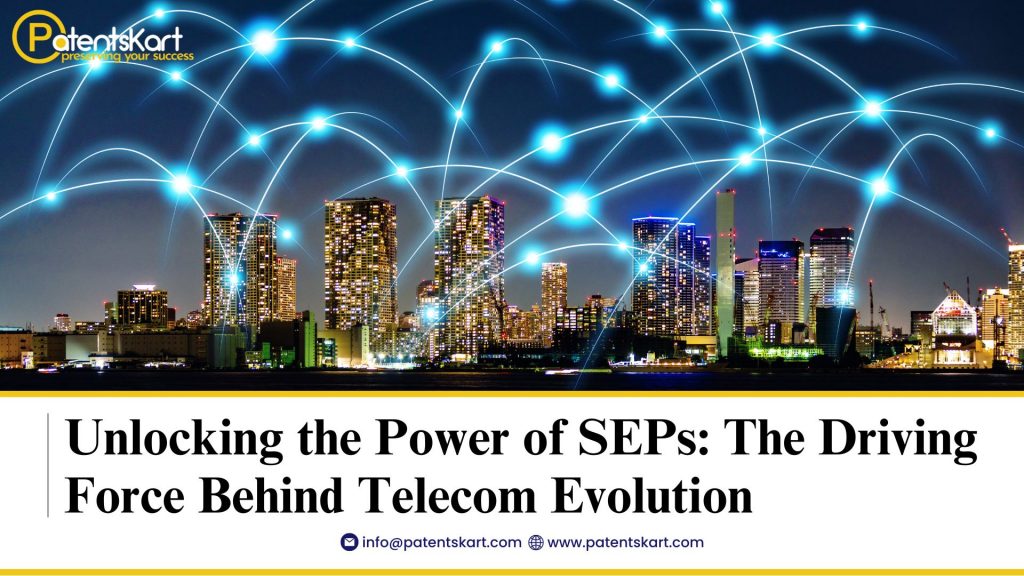Telecom innovation now depends on the strategic control and scientific analysis of Standard Essential Patents. Within this universe, the most commercially decisive category is 5G SEPs. Their owners influence interoperability, licensing economics, and even the direction of future standards. But the competitive advantage doesn’t come from merely holding patents — it comes from correctly identifying which declared assets are genuinely essential and how they impact business decisions. This article explains the strategic stakes of 5G SEPs, the data flaws that distort reality, and the rigorous intelligence approaches now required to win in the era of connectivity-driven global competition.
Introduction-The Invisible Infrastructure of Modern Networks
Across industries, connectivity has become non-negotiable: in autonomous mobility, cloud gaming, virtual healthcare, and industrial automation. Yet every device that interfaces with advanced networks inherits an unseen dependency — it must comply with standards enabled by patents. That subset of essential patents is largely composed of 5G SEPs. Their existence determines which companies can legally ship products and which must pay for access. In this environment, misunderstanding essentiality directly translates into financial misjudgment, avoidable disputes, and poorly aligned product strategy.
The telecom race is no longer decided by radio performance alone. It is increasingly decided by informational advantage — by who knows the true value and constraints behind 5G SEPs better than their competitors.
Why Accurate Essentiality Matters More Than Declaration Counts
A patent is only a 5G SEP if a product cannot implement the 5G standard without infringing one of its claims. In legal practice, essentiality is a technical and evidentiary conclusion — not a marketing statement. Public declarations are voluntary submissions and often include blanket assertions, missing claim details, inconsistent formats, and OCR errors. Many organizations make strategic declarations that overestimate their influence in standards.
When a company confuses declared volume with real essentiality, four predictable consequences follow:
• Licensing budgets become inflated due to false exposure
• Negotiations weaken when challenged with claim evidence
• Litigation risk rises from incorrect assumptions
• Roadmaps get constrained by unexpected royalty implications
A dataset of 5G SEPs that hasn’t been validated is not intelligence — it is a liability dressed as insight.
What Real SEP Intelligence Looks Like
The transformation from raw declarations to executive-grade intelligence requires discipline. Industry leaders now analyze 5G SEPs with methodologies that go far beyond counting:
• Mapping claims directly to normative standard sections
• Scoring legal enforceability using citation strength and claim architecture
• Modeling remaining patent life and terminal disclaimers
• Identifying family redundancies to isolate the real blocking assets
• Analyzing overlap between assignees to forecast negotiation pressure points
The output doesn’t simply show who holds 5G SEPs — it shows why those rights matter, how long they will remain powerful, and how they alter the economics of market entry.
Decisions That Become Smarter with SEP Intelligence
1. Licensing and Cross-Licensing
When licensing executives negotiate with verifiable essentiality insight, they can base offers not on perceived power, but on proven influence. Royalty payments align closer to technological significance instead of inflated positioning.
2. Product Architecture
Engineers can evaluate whether a minor modification avoids dependence on a cluster of 5G SEPs, instantly altering long-term profitability. Smart architecture can save more money than smart negotiation.
3. Vendor Selection and Procurement
Procurement teams equipped with 5G SEP exposure analytics can avoid suppliers who indirectly force unfavorable licensing obligations.
4. Investment and M&A
The valuation of a telecom company increasingly depends on claim-level analysis of its most influential 5G SEPs, not simply portfolio size.
Across all these cases, a truth emerges: companies that understand the essential patent environment will always outperform those caught reacting to it.
The Emerging Geography of Intellectual Power
Leadership in 5G SEPs signals control over the technological agenda. The distribution of influence has shifted dramatically from 4G to 5G. Asian innovators have surged in active claim concentration. European leaders retain strength in radio architecture and protocol control. U.S. entities remain dominant in foundational semiconductor and security components.
But numbers alone do not define power. A company with a smaller portfolio of highly influential 5G SEPs can hold more negotiating leverage than a company with thousands of weak declarations. Essentiality strength, not size, determines authority in standard-driven markets.
This changing landscape explains why early intelligence in 5G SEPs is already being used as a predictor for who will shape 6G — and who will follow.
The Transparency Crisis in SEP Data
The volume and variability in declaration sources introduces structural opacity. Standards bodies publish information in different formats. Many declarations lack patent numbers altogether. Essentiality assessments by third parties are sometimes anecdotal or applied inconsistently. Data pipelines often lose accuracy due to poor normalization.
The result is uncertainty that impacts billions:
• Royalty stacking becomes unpredictable
• Licensing deals drag into conflict
• Investors overvalue or undervalue corporate assets
• Public policymakers cannot benchmark fair access properly
When billions of dollars are at stake, companies cannot afford to rely on a broken mirror of 5G SEPs. Credibility requires validation, governance, and repeatability.
What Ethical, Defensible SEP Governance Demands
SEP intelligence influences licensing, innovation access, and geopolitical technology resilience. Therefore, data ethics matters as much as analytics power. Responsible organizations adopt:
• Transparent essentiality scoring documentation
• Human-in-the-loop review for contested assessments
• Audit trails from claim to standard clause
• Ongoing refresh cycles aligned with SSO releases
• Safeguards to prevent systemic bias in datasets
Governance is not bureaucracy — it is protection of trust, value, and strategic intent in the management of 5G SEPs.
Realistic Examples of Intelligence Impact
One equipment manufacturer performing a claim-level review discovered that its primary exposure was limited to fewer than two dozen 5G SEPs. With that discovery, a negotiation shifted from multi-portfolio licensing to a targeted agreement, reducing costs and ending threats of injunction.
In another case, an automotive company designing V2X connectivity identified that a chipset partner’s technology relied heavily on a competitor’s strongest 5G SEPs. Adjusting the integration sequence reduced dependency risk and strengthened procurement leverage.
Strategy transforms immediately when uncertainty becomes visibility.
The Urgency: 6G Starts With Today’s Position
Every major company preparing for 6G is already analyzing 5G SEPs intensely. Why? Because patents with broad foundational claims will span standards generations. Entities that learn today how to direct essentiality will shape the next technology era — particularly as emerging standards incorporate AI-native networking, satellite integration, and sub-terahertz performance.
Tomorrow’s leaders aren’t waiting. They are securing leverage through 5G SEPs today.
Why insideSEP Is the Industry Benchmark for SEP Intelligence
The telecom ecosystem can only operate with confidence when essentiality insights are validated, traceable, and continuously refreshed. That is precisely the foundation of insideSEP, PatentsKart’s advanced intelligence platform designed to convert SEP complexity into strategic clarity.
InsideSEP delivers:
• Comprehensive coverage of global 5G SEP declarations
• Claim-level essentiality indicators linked to standard specifications
• Fully normalized global patent families with assignee reconciliation
• Portfolio ranking powered by enforceability and lifecycle analytics
• Dynamic dashboards for cross-licensing negotiation and dispute strategy
• Audit trails for every essentiality decision, ensuring compliance and defensibility
Unlike raw datasets, insideSEP combines rigorous data engineering, expert review, and interactive decision intelligence. Licensing leaders, chief IP counsels, and standards strategists use insideSEP to quantify leverage, reduce exposure, and make decisions aligned with both commercial goals and global standards evolution.
In a market where uncertainty creates unnecessary cost, insideSEP gives organizations what competitors lack: verified confidence.
Conclusion-Knowledge Wins Markets
Telecom leadership used to be defined by infrastructure scale. Then by device innovation. Now, the defining factor is clarity of rights — knowing which patents frame the boundaries of what is legally and technically possible.
Companies that treat 5G SEPs as a precisely measured, continuously validated asset gain:
• Licensing advantage
• Litigation resilience
• Stronger supply chain control
• More powerful influence in standards forums
There is no strategic upside in guessing. In the telecom future, only those with disciplined essentiality intelligence will lead. Winning isn’t about having everything — it’s about knowing everything that matters, quicker and with certainty.
For more info, visit www.patentskart.com or contact us at info@patentskart.com.







